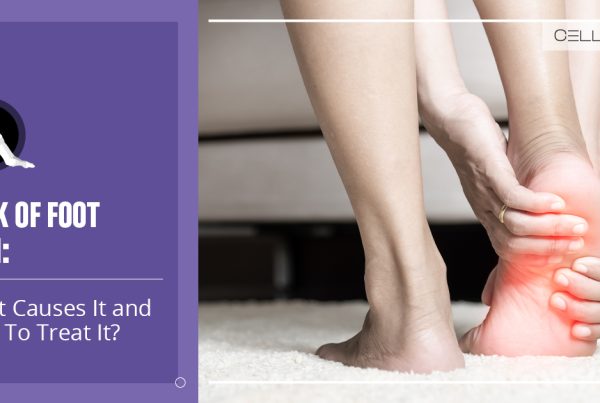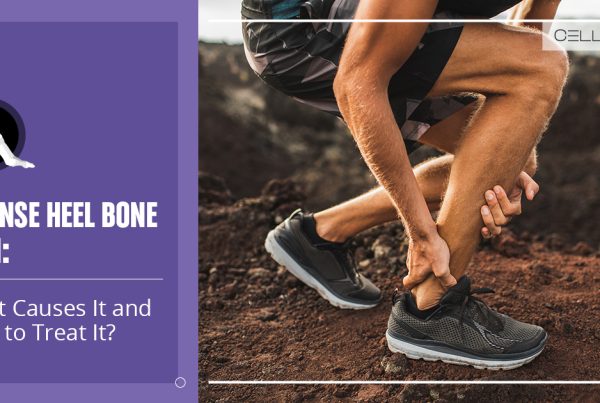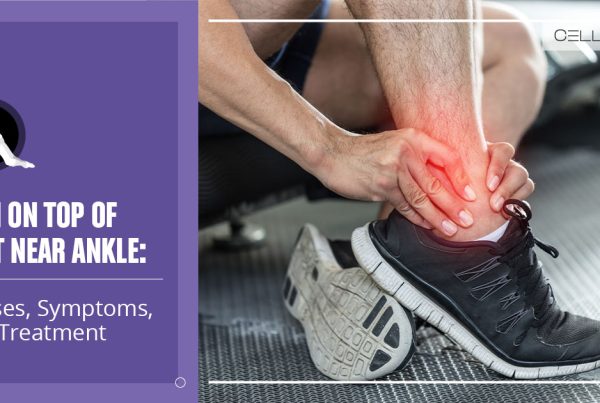Published on: March 25, 2024 | Updated on: January 18, 2025
Side heel pain is a debilitating condition that requires immediate treatment to improve. If left untreated, it won’t only limit your mobility but also make your nights restless. The pain can be acute or stabbing, depending on its cause.
Many factors can lead to pain in the heel, but two factors are the most common in side heel pain: peroneal tendonitis and sinus tarsi syndrome. Both conditions are caused due to extensive weightlifting, performing high-impact activities, running, or wearing inadequate footwear.
Most lateral or side heel pains can be treated with at-home methods. However, for severe conditions, you may have to opt for cell-based therapies (stem cell therapy) or platelet-rich plasma (PRP) therapy.
Causes of Side Heel Pain
Side heel pain often starts mild and increases gradually. In most cases, it is occasional and only felt once or twice a day. The two most common factors for side heel pain include the following:
Peroneal Tendonitis
The peroneal tendons connect the peroneal muscles from the calf’s base to the foot. The first tendon is connected to the foot’s outer or lateral area, while the other is attached to the inside of the foot’s arch.
Any inflammation in these tendons is known as peroneal tendonitis or peroneal tendinopathy. It is associated with structural changes in the affected tendon, primarily due to running, jumping, extensive physical therapy, heavy lifting, lower limb imbalances, or improper footwear.
Peroneal tendonitis causes intense or mild pain in the heel’s side, often accompanied by swelling.
Sinus Tarsi Syndrome (STS)
The sinus tarsi is the tube running between the calcaneus and talus bones found in the foot. It consists of many structures that play a major role in stabilizing the foot and ankle.
A traumatic injury, ankle strain, or overuse of these bones can result in sinus tarsi syndrome. It can also occur due to repetitive standing or walking. People with an over-pronated foot (inward or downward rolled foot) are more likely to suffer from sinus tarsi syndrome.
This condition leads to mild to severe lateral heel pain and swelling.
Common Symptoms of Side Heel Pain

People with peroneal tendinopathy typically experience side heel pain that worsens over time. You may also feel pain when twisting or turning your foot. The common symptoms of side heel pain include the following:
- Soreness or tenderness in the side heel
- An unstable foot
- Difficulty walking or standing
Patients suffering from sinus tarsi syndrome are most felt when standing, moving the foot in and out, or walking on rough terrain.
Treatment for Side Heel Pain
The best treatment for side or lateral heel pain is targeted towards taking off the pressure from the heel. It will allow the irritated or inflamed structures to settle and heal. Once your pain disappears, you can move on to improving your ankle’s range of motion and balance.
The most recommended option is RICE (rest, ice, compression, elevation), which you can easily practice at home. Your doctor may also recommend some anti-inflammatory and pain relief medications.
RICE
The right way to perform the RICE procedure is as follows:
- Rest. Whether you feel occasional or recurring side heel pain, rest your foot immediately and keep weight off it.
- Ice. You should also take an ice cube and wrap it in a towel to make an ice pack. Apply it to the affected part of the heel multiple times a day for up to 20 minutes to relieve pain.
- Compression. Wear a compression garment or an elastic bandage around your heel to relieve the pressure. Ensure you do not wrap your foot too tightly or injure your heel even more.
- Elevation. You must also elevate your foot above the heart to minimize swelling. Simply lie down and put some pillows underneath to raise your foot.
Non-Steroidal Anti-Inflammatory Drugs (NSAIDs)
If your side heel pain is due to a mild cause, your doctor may prescribe non-steroidal anti-inflammatory drugs (NSAIDs) to relieve inflammation. They may also opt for corticosteroid injections to improve the swelling and pain in the heel.
Extracorporeal Shockwave Therapy
Extracorporeal shockwave therapy (ESWT) involves directing high-energy sound waves into the inflamed area. This treatment stimulates blood vessel dilation to promote new tissue development and recovery. In most cases, ESWT provides pain relief almost immediately.
Cell-Based Therapy
More commonly known as stem cell therapy, cell-based therapies include extracting healthy cells from the patient’s body, concentrating them, and reinjecting them into the affected area to promote new tissue development. It is based on regenerative medicine, ensuring minimal incisions and pain.
At CELLAXYS, we perform two types of cell-based therapies:
- Minimally Manipulated Adipose Tissue (MMAT) Transplant. In this procedure, the doctor extracts healthy cells from the adipose (fat) tissues, processes them, and reinjects them into the affected heel area. The best part about MMAT is that the doctor can perform it in multiple places in the same procedure.
- Bone Marrow Concentrate (BMAC). BMAC involves extracting highly concentrated cells from the bone marrow and reinjecting them into the injury site.
Cell-based therapies are performed within 1.5 to 2 hours, and you may be able to go home right after the procedure.
Platelet-Rich Plasma (PRP) Therapy
PRP is a popular surgery alternative for athletes to treat spine and orthopedic-related issues. The procedure includes taking the patient’s blood sample, processing it to separate platelets from it, and reinjecting them into the affected heel area.
Platelets are healing components of our body that promote new tissue development in case of injury or inflammation. They perform three key functions: release 10 growth factors, attract healing cells from the blood, and produce a web-like scaffolding called fibrin. A high number of platelets in the affected area leads to early recovery.
PRP takes about 45 minutes to complete. Like cell-based therapy, PRP is also an outpatient procedure, so you can go home in a few hours.
Side Heel Pain: Recovery Time
Both regenerative medicine methods (cell-based therapy and PRP) instantly improve the side heel pain. At CELLAXYS, our patients report pain-free recovery in up to a few weeks.
With proper care and treatment, the side heel pain usually improves within one to two weeks. But that applies to mild cases. In severe conditions, your heel may take months to recover fully. It’s essential to consult a professional healthcare provider to shorten your recovery period for heel pain.
Sources
Footnotes
- Aldridge T. Diagnosing heel pain in adults. American family physician. 2004;70(2):332-8.
- Kim KH, Park BK, Kim DH. A case of lateral calcaneal neuropathy: lateral heel pain. Muscle & Nerve. 2016;54(4):801-4.
- Iradukunda D, Chu K, Obaid H. Lateral heel pain. Skeletal Radiology. 2013;42:1481-2.
- Vahdatpour B, Sajadieh S, Bateni V, Karami M, Sajjadieh H. Extracorporeal shock wave therapy in patients with plantar fasciitis. A randomized, placebo-controlled trial with ultrasonographic and subjective outcome assessments. J Res Med Sci. 2012;17(9):834-8.
- Dailey JM. Differential diagnosis and treatment of heel pain. Clinics in Podiatric Medicine and Surgery. 1991;8(1):153-66.
References
- What causes heel pain, and what to do about it. Medical News Today. Accessed 10/13/2023.
- Outer Heel Pain. Sydney Heel Pain. Accessed 10/13/2023.
- Heel Pain. Cleveland Clinic. Accessed 10/13/2023.
CELLAXYS does not offer Stem Cell Therapy as a cure for any medical condition. No statements or treatments presented by Cellaxys have been evaluated or approved by the Food and Drug Administration (FDA). This site contains no medical advice. All statements and opinions are provided for educational and informational purposes only.
Dr Pejman Bady
Author
Dr. Pejman Bady began his career over 20 years ago in Family/Emergency Medicine, working in fast-paced emergency departments in Nevada and Kansas. He has served the people of Las Vegas as a physician for over two decades. Throughout this time, he has been met with much acclaim and is now the head of Emergency Medical Services in Nye County, Nevada. More about the doctor on this page.
Dr Pouya Mohajer
Contributor
Pouya Mohajer, M.D. is the Director of Spine and Interventional Medicine for CELLAXYS: Age, Regenerative, and Interventional Medicine Centers. He has over 20 years of experience in pain management, perioperative medicine, and anesthesiology. Dr. Mohajer founded and is the Medical Director of Southern Nevada Pain Specialists and PRIMMED Clinics. He has dedicated his career to surgical innovation and scientific advancement. More about the doctor on this page.









